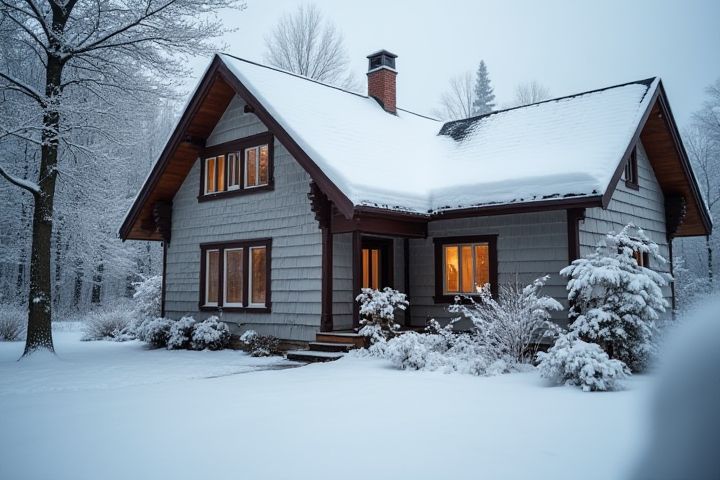
Begin by sealing gaps and cracks around windows and doors with weatherstripping or caulk to prevent drafts and improve energy efficiency. Insulate your attic and exposed pipes to reduce heat loss and protect plumbing from freezing. Check your heating system, ensuring you change filters and schedule maintenance to enhance performance during colder months. Drain and store garden hoses, and winterize outdoor faucets to prevent burst pipes. Lastly, consider installing storm windows or window film for extra insulation, optimizing your home's comfort and energy costs throughout winter.
How To Winterize A House Effectively
Seal windows and doors to prevent drafts
Sealing windows and doors effectively can reduce drafts and enhance your home's energy efficiency, saving you an average of 10-20% on heating costs during winter months. Use weatherstripping or caulk to create airtight seals around all windows and doors, preventing cold air from entering and warm air from escaping. Inspect for gaps or deteriorated sealant, paying close attention to edges and corners, as these areas are most susceptible to air leaks. Consider using a door sweep at the bottom of exterior doors, which can further block drafts and ensure a cozy indoor environment.
Insulate pipes to avoid freezing
To winterize your house effectively, focus on insulating pipes to prevent freezing and bursting during frigid temperatures. Use foam pipe insulation or heat tape to cover exposed pipes in unheated areas like basements, attics, and garages. Seal any gaps around windows and doors to minimize drafts that can affect the temperature of interior plumbing. Regularly check the temperature of your home and ensure your heating system is functioning efficiently to maintain a consistent environment for your pipes.
Clean gutters to prevent ice dams
Cleaning your gutters is crucial for winterizing your house, as clogged gutters can lead to ice dam formation, causing potential water damage. Start by removing leaves, twigs, and other debris from your gutters to ensure proper drainage during winter storms. After clearing the gutters, inspect downspouts to make sure they are free-flowing; consider extending them away from your home's foundation to divert water more effectively. Regular maintenance will not only prevent ice dams but also enhance the longevity of your roofing system and safeguard your home against winter weather challenges.
Check and maintain the heating system
To winterize your house effectively, start by checking and maintaining the heating system to ensure optimal performance during cold months. Schedule a professional inspection of your furnace or boiler, checking for any necessary repairs or replacements of filters, which can improve air quality and heating efficiency. Inspect ductwork for leaks and seal any openings to prevent heat loss, which contributes to higher energy bills. Finally, consider adding insulation to your attic and walls to enhance heat retention, keeping your home cozy and energy-efficient throughout winter.
Install storm windows or thermal curtains
Installing storm windows can reduce heat loss by up to 50%, significantly improving your home's energy efficiency during winter. These windows create an insulating barrier, helping to minimize air leaks and drafts that contribute to increased heating costs. Alternatively, thermal curtains can reduce heat loss through windows by 25%, providing an extra layer of insulation that keeps your living space warmer. By effectively utilizing these strategies, you can enhance your home's comfort while saving on energy bills this winter.
Inspect roof for damage and repair if needed
Inspecting your roof for damage is crucial to effective winterization. Look for missing shingles, cracks, and signs of wear that could lead to leaks during winter storms. Repair any identified issues promptly by replacing shingles or sealing cracks with roofing cement to prevent water infiltration. By ensuring a watertight roof, you protect your home from potential structural damage and costly repairs later on.
Set thermostat to a consistent temperature
Setting your thermostat to a consistent temperature, ideally between 55degF and 68degF, is essential for winterizing your house effectively. Maintaining this range prevents pipes from freezing while ensuring your home stays comfortable during colder months. A programmable thermostat can automate this process, allowing you to adjust settings according to your schedule and further enhance energy efficiency. By keeping the temperature stable, you minimize temperature fluctuations that could lead to costly repairs.
Reverse ceiling fan direction for warmer air circulation
To winterize your house effectively, adjusting the direction of your ceiling fans is essential for maximizing warmth and energy efficiency. Set your ceiling fans to rotate clockwise at a low speed, which helps to push warm air that rises back down into the living space. This process enhances heat distribution, ensuring that even the coldest spots in your home feel more comfortable during the winter months. By implementing this simple adjustment, you can enjoy a cozier atmosphere while potentially reducing heating costs.
Store outdoor furniture and hoses
Start by thoroughly cleaning your outdoor furniture to prevent mold and mildew during the winter months. Once dry, store it in a protected location, like a garage or shed, or use furniture covers specifically designed for outdoor use to shield it from the elements. For hoses, drain all water to prevent freezing, and then coil them neatly before storing them in a cool, dry place away from direct sunlight to extend their lifespan. Taking these steps ensures your outdoor items remain in pristine condition, ready for use when the warmer weather returns.
Test smoke and carbon monoxide detectors
Testing smoke and carbon monoxide detectors is crucial for winterizing your house, ensuring safety during the colder months. You should replace the batteries in these devices at least once a year, or when you test them and find an insufficient charge. Press the test button on each unit to confirm they are functioning properly; ideally, detectors should be located on every level of your home and near sleeping areas. Installing new detectors every 5 to 10 years is recommended, as older models may not respond as effectively to emergencies.
